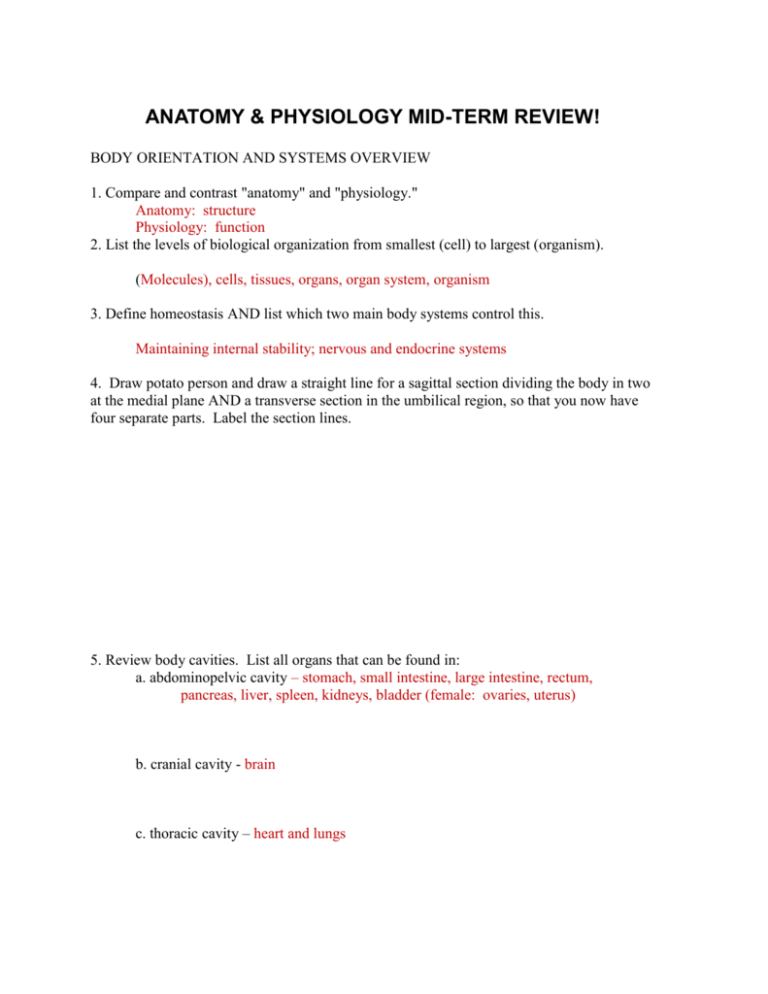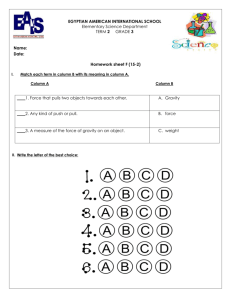ANATOMY & PHYSIOLOGY MID
advertisement

ANATOMY & PHYSIOLOGY MID-TERM REVIEW! BODY ORIENTATION AND SYSTEMS OVERVIEW 1. Compare and contrast "anatomy" and "physiology." Anatomy: structure Physiology: function 2. List the levels of biological organization from smallest (cell) to largest (organism). (Molecules), cells, tissues, organs, organ system, organism 3. Define homeostasis AND list which two main body systems control this. Maintaining internal stability; nervous and endocrine systems 4. Draw potato person and draw a straight line for a sagittal section dividing the body in two at the medial plane AND a transverse section in the umbilical region, so that you now have four separate parts. Label the section lines. 5. Review body cavities. List all organs that can be found in: a. abdominopelvic cavity – stomach, small intestine, large intestine, rectum, pancreas, liver, spleen, kidneys, bladder (female: ovaries, uterus) b. cranial cavity - brain c. thoracic cavity – heart and lungs 6. Review regional anatomy terms. Match column A with column B: COLUMN A COLUMN B a___arm a. brachial i___belly button b. cervical e___buttock c. digital h___chest d. femoral c___fingers and toes e. gluteal g___knee (anterior) f. oral f___mouth g. patellar b___neck h. thoracic d___thigh i. umbilical 7. Review function and organs of each body system: SYSTEM FUNCTION Integumentary protection from bacteria produces vitamin D regulates temperature Skeletal moves body, protects organs, produces blood ORGANS skin, lines cavities, surrounds organs bones, bone marrow Muscular moves skeleton and substances in body via circulatory and digestive systems heart, circulatory blood vessels, digestive system except liver and pancreas CNS and PNS (central and peripheral nervous systems) Nervous responds to environmental changes by transmitting electrochemical impulses Cardiovascular (circulatory) transportation of blood—food, hormones, oxygen, carbon dioxide and other wastes heart and blood vessels Respiratory adds oxygen, removes carbon dioxide from blood lungs Digestive breaks down food into building blocks Excretory (urinary) rids body of nitrogen wastes and regulates composition of blood mouth, esophagus, stomach, small intestines, large intestines, rectum, liver, pancreas kidneys, bladder Endocrine regulates homeostasis Reproductive allows production of offspring hypothalamus, pituitary, pineal, adrenals, parathyroid, thyroid, thymus, ovaries, testes female: ovaries, uterus male: testes BIOCHEMISTRY 1. Contrast organic with inorganic molecules and give human body examples. ORGANIC – C-based molecules/lipids, proteins, carbohydrates, nucleic acids INORGANIC – generally no carbon; salts, water, carbon dioxide 2. Which statement about enzymes is true? a. They are proteins. b. They form complexes with specific substrates (molecules). c. They are biological catalysts. d. They increase the rates of chemical reactions and lower heat needed. e. All of the above. 3. List macromolecules, their monomer building blocks, function, and body examples: Macromolecule Monomer Function Examples Carbohydrate Monosaccharide Main energy source for making Glucose ATP’s Starch; glycogen Storage for energy cell walls: chitin or Structures cellulose Lipid Phospholipid; steroid Forms double semi-permeable Membranes ring; triglyceride layer Cholesterol; waxes Functional molecules Fats; oils Glycerol and 3 fatty acid chains Protein Amino acid (20 kinds) Functional Antibodies; enzymes structural Collagen; elastin Nucleic acid Nucleotide: 5-carbon Carries genetic code; allows for DNA, RNA sugar, phosphate, Nprotein synthesis base CELLS AND TISSUES 1. Draw and label a “typical” animal cell with labels. Use the following: cell membrane, cytoplasm, ribosome, nucleus, chromatin, nucleolus, rough endoplasmic reticulum, smooth endoplasmic reticulum, Golgi apparatus, mitochondria, lysosomes, centrioles, microtubules 2. Choose the group of terms that best describes the process of diffusion: a. Passive; carriers; up a concentration gradient b. Passive: kinetic energy; down a concentration gradient c. Active; carriers; down a concentration gradient d. Active; kinetic energy; up or against a concentration gradient 3. Match terms in column B with description in column A: COLUMN A f___ energy-generating powerhouse of the cell b___ assemblies and packages materials to be secreted from the cell e___ provides supports for maintaining cell shape l___ synthesizes steroid hormones a___ forms the mitotic spindle and the base of cilia j___ site of protein synthesis g___ site of ribosome synthesis k___ membrane network studded with ribosomes h___ control center of the cell d___ sac of digestive enzymes c___ pigment granules, water vacuoles, etc. COLUMN B a. Centriole b. Golgi apparatus c. Inclusions d. Lysosome e. Microtubules f. Mitochondria g. Nucleolus h. Nucleus i. Plasma membrane j. Ribosome k. Rough ER l. Smooth ER 4. Complete the tissue chart below: Tissue Function Epithelial cover body surfaces Muscle movement Connective Structural Support - bone, cartilage Storage Media - adipose tissue (fat) Mechanical Protection - membranes Transportation - blood. conducts electrochemical impulses; conveys information about environment Nervous 5. Complete the following muscle table: Muscle type Structure description Skeletal striated, multinucleate, voluntary Smooth elliptical, involuntary Cardiac striated, branching, involuntary Body location skin; covers organs and lines cavities; lines digestive tract and blood vessels attaches to skeleton and skin; heart; inside digestive tract and blood vessels skeletal system, integumentary system, nervous system, circulatory system CNS & PNS (central and peripheral nervous systems) Location in the body attaches bones to bones and muscles to bones circulatory and digestive systems heart 6. Match the connective tissue types in Column B with the description in Column A. COLUMN A c___ Achilles was “done in” by damage to the tendon connecting his calf muscles to his heel. All tendons consist of this tissue. a___ no one is literally a “fathead” because the brain is unable to store this tissue. g___ has a high content of hard calcium salts b___ a soft packing tissue with a soft fluid matrix e___ forms the shock-absorbing pads between the vertebrae f___ glassy semi-hard tissue that covers bone ends at joint surfaces connects ribs to breastbone COLUMN B a. Adipose b. Areolar c. Dense fibrous d. Elastic cartilage e. Fibrocartilage f. Hyaline cartilage g. Osseous (bone) TISSUES AND INTEGUMENTARY SYSTEM 1. Where are mucous membranes located? a. In joint cavites b. Covering the heart c. Lining the stomach d. Covering the brain 2. Skin color is determined by ___. a. the amount of carotene in the stratum corneum and subcutaneous tissue b. pigments in the epidermis (melanin) c. the degree of oxygenation of the blood d. All of the above 3. List the functions of the skin: Body temperature regulation Production of vitamin D Protection from bacterial invasion Secretes wastes Prevents water loss Houses some sensory equipment (pressure, temperature) 4. What are the two most life-threatening concerns when a person has severe burns? dehydration infection 5. Acne is a disorder associated with inflammation of the ___sebaceous glands__. 6. What tissue describes the outer surface covering the heart? Visceral pericardium 7. Describe the ABCD method of monitoring moles. A = asymmetry (lack of balance or symmetry) B = border (border should be even all around, not indented or bumpy) C = color (check for color change; color should not be multiple colors) D = diameter should be less than 6mm SKELETAL SYSTEM INTRODUCTION 1. List four functions of the skeletal system: Support and protection Hematopoietic site Storage Provides levers for muscle activity 2. A bone that has essentially the same width, length, and height is most likely __. a. A long bone b. A short bone c. A flat bone d. An irregular bone 3. When exposed to vinegar, what components of bone matrix have been lost? calcium 4. The process of ossification (bone formation) in long bones includes: a. production of new bone matrix by osteoclasts b. breakdown of hyaline cartilage c. initial formation of bone matrix, with later replacement by cartilage d. destruction of the epiphyseal plates shortly after birth 5. In adult long bones, hyaline cartilage is found ___ a. in the medullary cavity b. between trabeculae c. on articular surfaces d. in the epitphyseal line e. in the diaphysis 6. The spinal cord passes through a large opening in the occipital bone. This opening is an example of a ___. d. facet a. foramen e. tubercle b. sinus c. ramus 7. Match the terms below with their descriptions: a. Bursitis b. Gout c. Osteoarthritis d. Rheumatoid arthritis c___ a consequence of “wear and tear” on joints; chiefly affects large weight-bearing joints; involves erosion of articular-cartilage and formation of bony spurs a___ examples are housemaid’s knee and tennis elbow b___ painful condition reflecting elevated levels of uric acid in blood; few joints affected d___ autoimmune disorder; joints affected bilaterally; involves pannus formation and gradual joint immobilization








